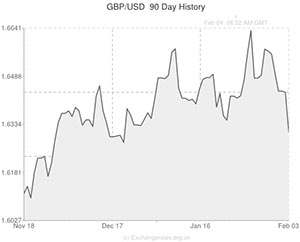
A weaker-than-anticipated UK Manufacturing PMI print sent the Sterling to US Dollar exchange rate (GBP/USD) spiraling below key technical resistance at 1.6300 last night. Prior to the factory output reading the Pound had not fallen below that level since December 17th.
Confounding expectations for a small rise from 57.2 to 57.3, January’s Manufacturing PMI came in at 56.7, which led to a bout of Sterling weakness against the ‘Greenback’.
However, despite the mild slide in total output, analysts generally saw the report as another positive reflection on the British economy. Job creation remained close to a 2.5-year high as did domestic demand, but the most optimistic element of the survey was the sub index for export orders, which posted its strongest score since February 2011. The encouraging export reading showed that demand for British goods is increasing both inside and outside of the European Union.
The US Dollar survived a nasty scare during the afternoon as the ISM Manufacturing survey, considered an important gauge of US economic output, fell dramatically from 56.5 to 51.3 – the fifth biggest monthly drop since 1948. It is thought that adverse weather conditions impacted performance causing the new orders sub index to shrink at its fastest rate for over 30 years.
The drastic decline in Manufacturing output during January is likely to hurt this Friday’s Non-farm Payroll report and could even persuade the Federal Reserve to pause the tapering process of its monthly asset purchasing programme. However, there is a stronger possibility that Fed policymakers will see the downturn as a weather-related anomaly and opt to continue winding down stimulus to help ease uncertainty within financial markets.
Separate reports showed that the Prices Paid index rose from 53.5 to 60.5 in January and that Construction Spending increased by 0.1% during December.
Sterling’s heavy decline of over -1.3 cents against the ‘Greenback’ led to a series of depreciations against all of its most-traded currency peers.
The Pound to Euro exchange rate (GBP/EUR) fell by -0.8 cents as Eurozone Manufacturing struck a near-3-year high of 54.0.
The Pound to Canadian Dollar exchange rate (GBP/CAD) slid by around -2.0 cents as optimism around an extension to the Keystone XL crude oil pipeline raised the prospect of increased USD flows into the ‘Loonie’.
The Sterling to Australian Dollar exchange rate (GBP/AUD) tumbled by around -1.5 cents as a Chinese PMI result of 50.5 boosted risk sentiment.
And the Pound to New Zealand Dollar exchange rate (GBP/NZD) stumped by over -2.5 cents as investors anticipated a -0.2% decline in the headline Unemployment Rate. The ‘Kiwi’ Dollar could appreciate again this evening if the jobless rate prints inline with economists’ forecasts of 6.0%, which would represent the lowest number since the first quarter of 2010.

Comments are closed.